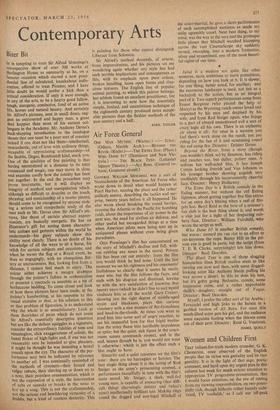Contemporary Arts
Biter Bit
it is tempting to treat Sir Alfred Munnings's retrospective show of over 300 works at Burlington House as summarily as he, on a famous occasion which started a new presi- dential line of calculated, knockabout indis- cretion, offered to treat Picasso; and I have little doubt he would prefer a kick than a critical consideration. If only it were enough, In any of the arts, to be a hearty good fellow, tough, energetic, combative, fond of an active life, horses and natural beauty. And certainly Sir Alfred's pictures, seen in small doses, sug- gest an extraverted and happy man, a great deal happier than most of his earnest col- leagues in the Academy. Mr. Anthony Devas's back-slapping introduction to the catalogue shouts that one must be a poor sort of creature indeed if one does not like them—intellectual, neurasthenic, out of love with ordinary things, incapable of appreciating craftsmanship—of the Stubbs, Degas, Rembrandt kind, mark you. One of the qualities of fine painting is that having surrendered at a distance to its total command and magic, one may move in close and examine coolly how the totality has been Put together. In the end the procedure may Prove inscrutable, but it will display an Integrity of method and manipulation which. although as difficult to describe as the touch. Phrasing, and musicianship of a master pianist, should come to be recognised by anyone mak- ing a serious and sympathetic study of the men such as Mr. Devas cites. Sir Alfred's pic- tures, like those of certain abstract expres- sionists, are basically energetic. He has an Illustrator's gift for noting down character- istic actions and gestures within the world he understands—his gipsy subjects show this ability most clearly. There is no doubt of his knowledge of all the ways to sit a horse, his relish for certain subjects and occasions; and when he waves the flag at a Royal event, he does so engagingly, with no obsequious flat- tery or unctuousness. But, looking first from a distance, I cannot find much to enjoy. The colour either achieves a meagre drabness through the painter's failure in orchestration or presents a spectacle as unsubtle as a bit of herbaceous bedding. To come closer and look at how these pictures have been made, at the Painter's handwriting, at his response to this visual stimulus or that, at his solution to this or that problem of figuration, is to understand why the whole is so unsatisfactory. Look at these flourishes of paint which do not assist Sir Alfred's essentially descriptive intention but are like the defiant squiggles in a signature, consider the extraordinary falsities of tone and meaningless, slick exaggerations of colour, the banal flicker of high-lights and, if one was not reasonably sure he intended toegive pleasure, it might be thought he was intending a brutal assault upon the eye. The character of the per- formance may best he indicated by reference to another art. I was continually reminded of the methods of crooners—their forced and vulgar rubato, their slurring up or down on to a note, their pointless ornamentation, which is not the expression of a style, the intervention of sobs or squeaks or breaks in the voice to hot up a song. This is not the craftsmanship, not the serious and bewildering virtuosity of a Stubbs, but a kind of rootless dexterity. This
is painting for those who cannot distinguish Liberacc from Solomon.
Sir Alfred's method descends, of course, from impressionism, and his pictures set Inc wondering again whether any style has had such terrible implications and consequences as this, with its emphasis upon pure colour. broken handling, loose open forms and viva- cious textures. The English line of popular animal painting, to which this painter belongs, has seldom found an excellent practitioner, but it is interesting to note how the essentially simple, limited, and unambitious technique of the eighteenth century produced more accept- able pictures than the flashier methods of the past century and a half.
BASIL TAYLOR


































 Previous page
Previous page